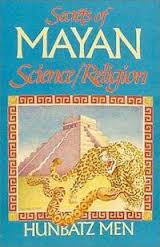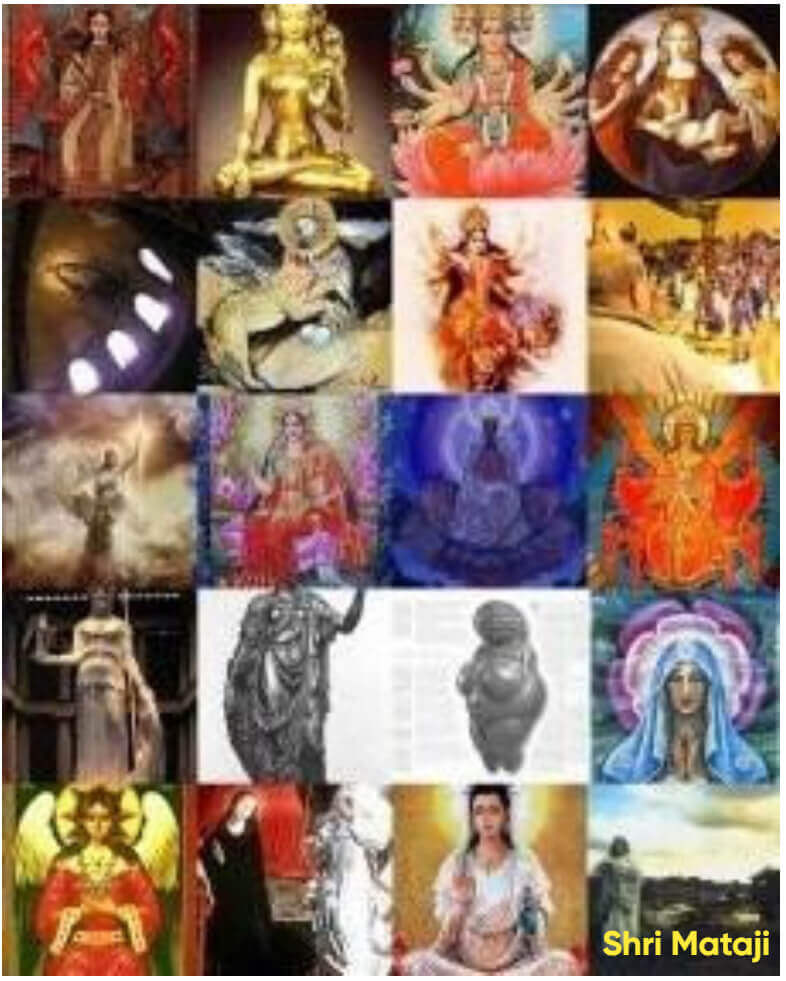Hunbatz Men, Secrets of Mayan Science/Religion
Hunbatz Men speaks of bones that remember, of sacred geometry encoded in the human spine, of cosmic cycles that awaken divine energy. The Mayan knew the sacrum as a portal—just as Hindus revered it as the seat of Kundalini. Across cultures, this bone is no accident of anatomy—it is the key to resurrection, memory, and spiritual ascent. Shri Mataji confirms this ancient truth: the cool breeze rises from the sacrum, and with it, the seeker is reborn. Hunbatz Men reveals that the sacrum bone holds cosmic memory and divine energy—echoing the universal truth of Kundalini, resurrection, and spiritual awakening.

"I think it is important to mention again the other ancient cultures, like those of India, where we find roots of words similar to peninsular Mayan. Valmiki wrote that the Naga Maya brought their culture to India around 2700 B.C., although we believe it was even earlier. We also maintain that they brought their culture to other parts of Asia and to Africa, where they were called Mayax according to Manetho, the Egyptian priest-historian.
There are notable similarities between Indian culture and the cultures of the Maya of Yucatan and other indigenous people of America, especially in esoterica. Figure 27 shows a clay sculpture from western Guerrero state. This piece represents a meditating figure seated in the Hindu 'lotus' position of yoga. Here is clear evidence, dear reader, that our ancestors practised this system of meditation in Mexico. Furthermore, the very word yoga exists in Mayan. Written yok'hah, it combines yok, 'above' or 'on top of,' and hah, 'truth.' ...
The word cizin esoterically implies a manifestation of our energies i.e., a practical application of knowledge. A flowering of radiation is visually represented by the serpent symbol of solar energy. The other extreme is cizin is in the coccyx, or the k'ul. Herein lie some of the secrets of Christ, the Jews, and other Catholic religious saints who exhibit auras surrounding their heads or bodies. It relates to what we saw in Figure 29, the meditating Mayan priest.
To conclude this brief analysis of the magic seven and its importance, we will cite another Hindi word: kundalini. This word exists in Mayan in two forms: k'ultanlilni and k'ulthanlilni. This again demonstrates the fact that world culture had roots which we, the peninsular Maya of Mexico, helped establish thousands of years ago. The Hindi word kundalini is the derivative evidence...
Continuing with our analysis of the words k'ultanlilni and k'ulthanlilni, we will try to discover new revelations through the Zuyua of pach than. As we just learned, in this form we use the words in reverse, i.e., in lil nat luk' and in lil nath luk', and study them in the contexts of etymology, linguistics, symbology, religion, science, etc.
K'ULTANLILNI & K'ULTHANLILNI:
K'u—Sacred, God, and name of the pyramid; the first sound a human makes upon arriving in this world.
K'ul—Coccyx, the sacred place where solar energy is deposited at the base of the spine. It can also mean k'u—sacred, God, etc.—with the L, contraction of lil, vibration.
K'ultan—Literally, it means coccyx and its location. From k'ul, coccyx, and tan, place. This word also says k'u, God or pyramid of lil—vibration, as seen above.
K'ulthan—Similar to above with the addition of than—to speak. k'ul—coccyx; than—to speak, or to speak to the coccyx, to God or to the pyramids, etc.
K'ultanlil—This word contains k'u—God or pyramid; L—vibration; tan—place; and lil—vibration. also k'ul—coccyx, implying that the coccyx is the location of the vibration of Hunab K'u, the Sun God.
K'ulthanlil—Composed of k'u—God, pyramid; L—vibration; than—to speak; and lil—vibration. K'ul is also coccyx; in the coccyx we can address the vibration of Hunab K'u.
K'ultanlilni—Finally one of the two complete words. K'u—God, pyramid; L—vibration; tan—place; lil—vibration. and ni—nose; also k'ul—coccyx. The composite meaning—the coccyx as the place of vibration is directly related to the nose because it is where the breath of the Sun God enters.
K'ulthanlilni—Similar to the previous word except for one significant variation. It means k'u—God, pyramid; L—vibration; than—to speak; lil—vibration; and ni—nose; also k'ul—coccyx. Coccyx of vibration, speak to the vibration, and also know how to breathe properly in order to generate movement of those faculties of Hunab K'u residing in the coccyx.
Through language, the Mayan culture instructs the people and enables them to develop the faculties which Hunab K'u placed in their bodies. Clearly, this process must become part of our consciousness so that we may become true Quetzalcoatls or Kukulcans. This process in uniquely expressed in our religious/scientific language, as we have demonstrated.”
Hunbatz Men, Secrets of Mayan Science/Religion
Bear & Company (August 1, 1989) pp. 111/132-35

110) Sri Kundalini
— She is coiled like a serpent. She is stated to assume 31/2 coils - the form in which Sri Lalita resides in sacrum bone of every human as potential state.
Sri Lalita Sahasranama
C. S. Murthy, Associate Advertisers and Printers, 1989
This family Woman Kundalini entering the royal road Susumna,
Taking rest at intervals in the secret places (in the cakras),
Embraces the supreme husband and causes the nectar to flow (in the Sahasrara.)
Cintamanistava
(source: R. A. Sastry, Lalita-Sahasranama, The Adyar Library and Research Centre, Madras, 1988.)
"That Kundalini in the Muladhara, sleeping in three and half coils, roused by Yogins, breaks through the six cakras as well as the three knots, called Brahma, Visnu, and Rudra-granthis and proceeding to the Sahasrara, from the moon's orb, which is the pericarp of the lotus, She causes nectar to flow.”
R. A. Sastry, Lalita-Sahasranama,
The Adyar Library and Research Centre, Madras, 1988, p 87.
The sakti called Kundalini in the form of a serpent, beautiful, fine as lotus, fibre, Resides in the Muladhara.
Biting the pericarp of the Muladhara which is like the pericarp of a lotus,
With its tail in its mouth and connected with the Brahmarandhra....
This energy unites with Siva in the thousand-petalled lotus.
This should be known as the supreme state (para),
And it is the cause of final beatitude.
Vamakesvaratantra, R. A. Sastry, Lalita-Sahasranama,
The Adyar Library and Research Centre, Madras, 1988, p 198.
May Kundalini, whose movements are secret and who by the blaze of the fire,
By the illumination of the sun and by the brightness of the moon,
Cause the ambrosia to flow through the seventy-two thousand channels,
And make us contented.
Sukasamitha, R. A. Sastry, Lalita-Sahasranama,
The Adyar Library and Research Centre, Madras, 1988, p 198.
Hunbatz Men, Secrets of Mayan Science/Religion: An Academic Exploration of the Mayan "Kundalini"
Abstract
This paper delves into the linguistic and spiritual connections between the ancient Mayan and Hindu traditions, as proposed by Mayan elder and scholar Hunbatz Men. The central focus is on the assertion that the Sanskrit term kundalini, representing the dormant spiritual energy in Hinduism, has direct linguistic and conceptual parallels in the Mayan words k'ultanlilni and k'ulthanlilni. Through a comparative analysis of etymology, symbolism, and esoteric practices, this paper examines the validity and implications of this proposed connection, shedding light on potential cross-cultural spiritual technologies and ancient wisdom traditions.
Introduction
The study of ancient civilizations often reveals surprising parallels in their spiritual and scientific understanding of the cosmos and the human condition. One such intriguing connection is proposed by Hunbatz Men in his work, Secrets of Mayan Science/Religion, where he posits a direct link between the Hindu concept of kundalini and specific Mayan terms. This paper will explore this assertion, analyzing the linguistic evidence presented by Men and examining the broader context of Mayan and Hindu esoteric traditions. The primary source for Men's claims is his book, supplemented by information from the website adishakti.org, which further explores the connection between Mayan serpent mythology and the Hindu concept of the divine feminine energy, or Shakti.
The Linguistic Bridge: Kundalini and its Mayan Counterparts
The cornerstone of Hunbatz Men's argument is the linguistic similarity between the Sanskrit word kundalini and the Mayan terms k'ultanlilni and k'ulthanlilni. He provides a detailed etymological breakdown of these Mayan words to reveal their esoteric meaning.
Deconstructing the Mayan Terms
According to Men, the Mayan words can be broken down as follows:
- K'u: Sacred, God, pyramid.
- K'ul: Coccyx, the sacred place where solar energy is deposited.
- Tan: Place or location.
- Than: To speak.
- Lil: Vibration.
- Ni: Nose, related to breath.
From this, Men constructs the meanings of the two terms. K'ultanlilni is interpreted as "the coccyx as the place of vibration is directly related to the nose because it is where the breath of the Sun God enters."[1] K'ulthanlilni is similarly interpreted, with the addition of "to speak," suggesting a conscious interaction with this energy: "Coccyx of vibration, speak to the vibration, and also know how to breathe properly in order to generate movement of those faculties of Hunab K'u residing in the coccyx."[2]
Conceptual Parallels with Kundalini
The parallels with the Hindu concept of kundalini are striking. Kundalini is derived from the Sanskrit word kundala, meaning "coiled," and is often depicted as a serpent coiled at the base of the spine in the muladhara chakra. This energy, when awakened, rises through the central energy channel, the sushumna nadi, activating the chakras and leading to spiritual enlightenment. The Mayan concept, as described by Men, shares several key elements:
- Location: Both traditions identify the base of the spine (coccyx/sacrum) as the seat of this energy.
- Energy/Vibration: The Mayan concept of lil (vibration) is analogous to the Hindu concept of prana or shakti, the life force energy.
- Breath: The Mayan emphasis on the nose (ni) and breath is central to yogic practices for awakening kundalini, known as pranayama.
- Serpent Symbolism: The serpent is a powerful symbol in both cultures. In Hinduism, kundalini is the "serpent power." In Mayan tradition, the feathered serpent deity, Kukulkan (or Quetzalcoatl in Aztec), represents the union of the earthly and the divine. The descent of the serpent of light on the pyramid of Kukulkan at Chichén Itzá during the equinoxes is a powerful visual representation of this energy.
Cultural and Historical Context
Hunbatz Men further supports his claims by suggesting a historical link between the two cultures. He references the work of Valmiki, who wrote that the "Naga Maya" brought their culture to India around 2700 B.C.[3] This suggests a possible diffusion of spiritual and scientific knowledge from the Americas to Asia. While this is a controversial claim that is not widely accepted by mainstream historians, it provides a potential explanation for the observed similarities.
"There are notable similarities between Indian culture and the cultures of the Maya of Yucatan and other indigenous people of America, especially in esoterica... Here is clear evidence, dear reader, that our ancestors practised this system of meditation in Mexico. Furthermore, the very word yoga exists in Mayan. Written yok'hah, it combines yok, 'above' or 'on top of,' and hah, 'truth.'"[4]
Conclusion
The work of Hunbatz Men presents a fascinating and thought-provoking exploration of the potential connections between ancient Mayan and Hindu spiritual traditions. His linguistic analysis of the terms k'ultanlilni and k'ulthanlilni as Mayan equivalents of kundalini offers a compelling, if not definitively proven, argument for a shared understanding of a powerful spiritual energy located at the base of the spine. The parallels in symbolism, anatomical location, and the role of breath are too significant to be dismissed as mere coincidence. While further research is needed to substantiate the historical claims of cultural diffusion, Men's work opens up a rich field of inquiry into the interconnectedness of ancient wisdom traditions and the universal human quest for spiritual awakening.
References
[1] Men, Hunbatz. Secrets of Mayan Science/Religion. Bear & Company, 1989, p. 135.[2] Men, Hunbatz. Secrets of Mayan Science/Religion. Bear & Company, 1989, p. 135.
[3] Men, Hunbatz. Secrets of Mayan Science/Religion. Bear & Company, 1989, p. 111.
[4] Men, Hunbatz. Secrets of Mayan Science/Religion. Bear & Company, 1989, p. 111.
[5] "Temple of Kukulkan – Kundalini Awakening and the Return of the Feathered Serpent." Adishakti.org.
Related Articles
Kukulcan's Return or Kundalini Goddess within?Hunbatz Men, Secrets of Mayan Science/Religion
On the Day of Judgment, Resurrection will be from Coccyx
The Mesoamerican Sacrum Bone


